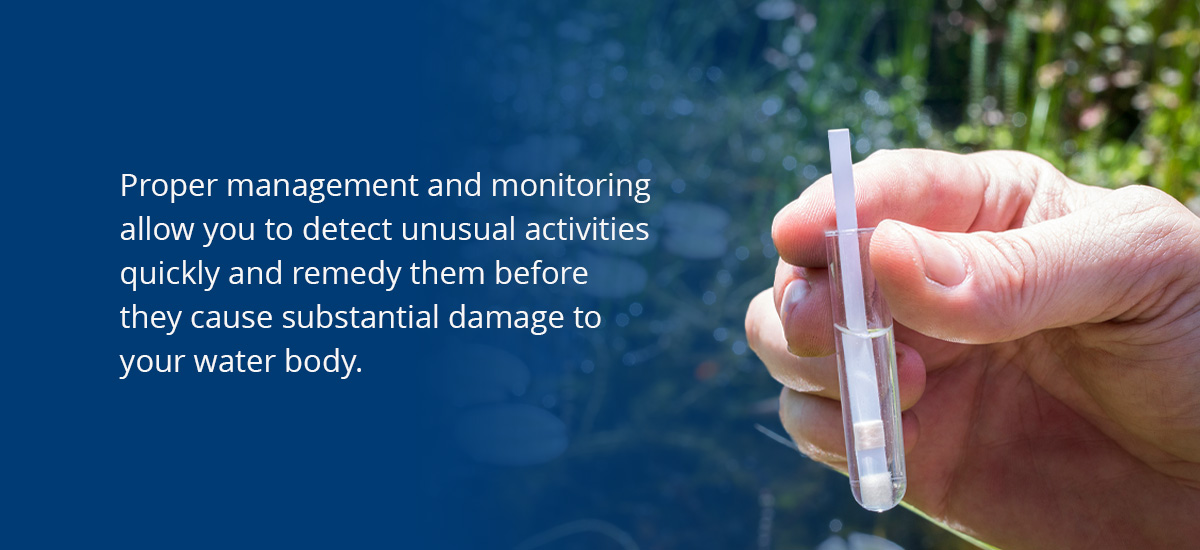There are many ways to know if your lake or pond needs water quality testing. A few examples include the presence of algae, dead fish, lack of wildlife and plant life, poor water clarity and murky or cloudy water surfaces.
Ensuring periodic water quality management and monitoring helps keep your pond or lake in peak condition. It allows you to provide the optimal environment for plants and animals to flourish and prevent anomalies before they spread to other parts of the water body.
This guide discusses these signs in detail and provides tips on keeping your pond or lake clean throughout the year.
What Is Water Quality Testing?
Water quality testing involves assessing a water body, such as a pond or lake, to determine its health and suitability for a particular purpose. The water quality testing professional evaluates a water body’s physical and biological parameters and provides appropriate solutions to remedy any anomalies. Water quality testing can also be a preventative measure to ensure the pond or lake is in peak condition all year.
8 Signs You Need Water Quality Testing
Here are eight signs your pond or lake needs water quality testing:
1. Algae
Algae blooms are one of the most common problems pond and lake owners encounter. It causes your water body to discolor and makes it unappealing. Algae blooms may harbor toxins that can pose severe health complications. Three types of algae are usually present in pools and lakes, each having distinct physical characteristics:
- Planktonic algae: Lakes typically have some planktonic algae under the surface, which are invisible or healthy to aquatic life or water quality at normal levels. However, elevated algae levels may discolor the water body and disrupt its ecosystem. Large quantities of algae bloom give the lake or pond a “pea soup” or greenish-blue paint appearance.
- Filamentous algae: Filamentous algae, also known as pond scum, are common in lakes and ponds — they can grow excessively when exposed to nutrients like nitrogen or phosphorus. There are different types of filamentous algae, each possessing unique physical characteristics. For example, spirogyra has a greenish look and slimy feel, cladophora is cottony, and pithophora has a coarse texture like horse hair.
- Macrophytic algae: Macrophytic algae, also known as muskweed, stonewort and chara, are complex, multi-celled organisms with the appearance of a plant with identifiable leaves and stems. They grow on the floor of ponds and can be covered in calcium, giving them a crusty, gritty feeling. Macrophytic algae provide food and shelter for fish but can be unhealthy when in excess.
2. Murky or Cloudy Water
Murky water results from oxygen depletion in the water. This may be attributed to excess algae growth, but there are other possible explanations, including:
- Poor circulation: When the pond or lake absorbs oxygen at the surface but cannot reach the bottom due to poor circulation and stratification, the water can’t self-purify as it should. The consequence is the hazy or cloudy appearance you see.
- Runoff: Residential and agricultural runoffs may carry additional nutrients which can accelerate plant growth. This can cause oxygen to deplete faster and affect your pond or lake’s health.
3. Foam or Scum on Top of the Water
The presence of foam or scum on the water surface is typically caused by a build-up of protein from decaying organic matter at the bottom of the lake or pond. This may be prevented by regularly removing leaves, flowers, twigs and other debris from the water body. If they have already gathered on the surface, you may install a filtration system to keep the water clean, use muck remover tablets or scoop them using a long-handled net.
4. Dead Fish
When you often see dead fish in your lake or pond, then it’s likely the water is unhealthy. This may be caused by many factors, including water pollution, disease or lack of oxygen. When you regularly see fish floating lifelessly in your pond or lake, especially in large quantities, contact a pond or lake water testing professional near you as soon as possible. Removing the fish and testing the water early helps mitigate the spread of toxins into other parts of the water.
5. Lack of Wildlife
Healthy ponds typically attract different wildlife species, including reptiles, birds and small mammals. If you notice a lack of wildlife around your pond, it could be a sign that the water is polluted. A pond water quality tester can assess your water quality and provide helpful solutions.
6. Lack of Plant Life
Plants are essential to the pond or lake’s ecosystem. Besides helping regulate the concentration of oxygen and carbon dioxide, they provide shelter and food for fish and other aquatic creatures. If plants can’t survive in the pond or lake, it may be a sign that something is wrong.
7. Poor Water Clarity
Let’s admit — getting pond water completely clear is almost impossible. However, an unusually brownish or bright green pond can be telling. Poor water clarity can be caused by the presence of excess algae or sediments in the water. When in doubt, reach out to a pond water quality testing company near you.
8. Foul Odor
The presence of algae, dead fish and other materials can cause the water to smell unpleasant. Also, improper aeration can cause pond waste to pile up in the water and the shore, decaying and releasing excess gas. This results in a chemical imbalance that can endanger underwater wildlife, fog water clarity and cause a foul stench. Have the water professionally tested and treated if you notice any unusual smell.
How Do You Maintain Pond Water Quality Standards?
Simple — ensure proper pond water quality management and monitoring. Besides creating a fantastic atmosphere on and around your property, lakes and ponds host different species of aquatic plants and wildlife. Proper management and monitoring allow you to detect unusual activities quickly and remedy them before they cause substantial damage to your water body. It helps you provide the optimal environment for aquatic flora and fauna to flourish and ensure your lake or pond is in peak condition.
Professional water quality testers can assess your lake or pond and provide the appropriate treatment for the following:
- pH
- Phosphate
- Dissolved oxygen
- Nitrates
- Nitrites
- Ammonia
- Hardness
- Salinity
- Alkalinity
- Temperature
- Turbidity
- Conductivity
- Clarity
- Oxidation-reduction potential (ORP)
- Fecal coliform
- E.coli
Save Your Pond by Contacting AEC
Ensuring preventative maintenance keeps your lake or pond in peak condition and allows you to detect anomalies before they cause damage to plants, animals and any other users of the water body. Therefore, it’s essential to partner with a professional water quality tester dedicated to serving you.
Aquatic Environment Consultants (AEC) has provided pond management services for over three decades. We offer ongoing pond management and maintenance services, using cutting-edge techniques to exceed your expectations. Request a consultation online today or call us at 717-208-8015!




Add Comment